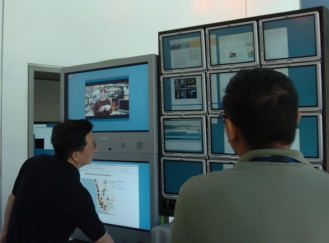RESCUE ALL-Hands Meeting Showcases Successes and Plans for Future
|
San Diego, CA, July 6, 2007 -- RESCUE (Responding to Crises and Unexpected Events) project personnel from participating institutions across the country attended RESCUE's annual ALL-Hands Meeting (AHM), hosted by the UCSD division of Calit2 on June 21-22. Project researchers took part in a series of presentations and discussions about the project's successes and made plans for the final year and beyond.
The goal of the RESCUE project is to explore and develop techniques and technological innovations which will improve and expedite the delivery of critical information - the right details, to the right people, at the right time - during crisis response. The aim is to radically transform the ability of responding organizations to gather, manage, use, and disseminate information within emergency response networks and to the general public.
"RESCUE is a unique information technology research project in at least two ways," says Kathleen Tierney, director of the Natural Hazards Research and Applications Information Center, Institute of Behavioral Science, "First, the personnel are keenly interested in understanding how individuals and organizations respond to crises under real-world conditions."
|
"And second," Tierney continues, "to a greater degree than most other computer scientists and technologists, the RESCUE team recognizes the importance of collaborating with social scientists and disaster experts." An Information Technology Research project (ITR) of the National Science Foundation, RESCUE is an interdisciplinary effort that brings together researchers from a variety of fields including computer and networking scientists, engineers, social scientists, disaster science experts, and students in these fields.
RESCUE has made strong efforts to understand how crisis response systems function during actual disaster conditions. "Such research spans both the use of technology by crisis management organizations and the plans and intergovernmental agreements that go into effect when disaster strikes," points out Tierney, who is also a professor of sociology at the University of Colorado at Boulder.
"Over the past four years, RESCUE researchers have engaged in several breakthrough technologies," says Sharad Mehrotra, director of the RESCUE project and a professor of information and computer science at UC Irvine. He continues, "These technologies, coupled with advances in social science, have been used to develop a variety of artifacts of direct relevance to first responders."
|
The project has established close contacts with emergency responders and emergency managers in a number of communities, including Irvine, San Diego and Ontario, CA, as well as Urbana-Champaign, IL. Many of the RESCUE artifacts have been developed in close collaboration with front-line emergency personnel and are already being tested and deployed by various organizations.
"We have made significant progress," notes co-principal investigator (co-PI) Nalini Venkatasubramanian, "in taking the research that we have been doing in all of RESCUE's different projects and tying them down into real artifacts that are actually being put into use." Venkatasubramanian is also a professor of information and computer science at UCI.
Artifacts developed by RESCUE to date include: a disaster portal that enables bidirectional flow of information between response organizations and citizens (deployed at the City of Ontario); a peer-based traffic awareness system (currently in use by about 15,000 travellers a month in the San Diego area, the system will be rolled out in the Los Angeles area shortly); an organization-based crisis alert system (to be pilot-tested in the Anaheim School district in collaboration with industry partners); a Disaster Management Information System (DMIS) augmented by authentication and trust technologies; an evacpack system which embodies the concept of "human-as-sensor" for a revolutionary new approach to reconnaissance; and the Metasim simulation environment for large-scale crisis simulation that enables testing and validation of the role of information technologies in response.
The technological advances made by RESCUE include: new methodologies for integrated multimodal data extraction; exploitation of peer-oriented technologies for scalable and fault tolerant information dissemination and content customization; wireless networking in the extreme; a new methodology for information sharing; integration framework for diverse heterogeneous simulators; and theoretical underpinnings of privacy and new privacy technologies that explore trade-offs between utility of information and loss of privacy.
|
A poster session highlighting current and ongoing research took place on the first day of the meeting, giving the attendees additional details of the work done by RESCUE's researchers. The theme for this year's AHM was integration, seeing how work by the various subgroups of RESCUE might be further integrated.
"I found the meeting very interesting," says RESCUE researcher Mirko Montanari of UCI, "because we get to know the different research in detail and can find the common points between them, then collaborate."
"The final year of RESCUE will focus on continued integration of the primary technologies developed by RESCUE into artifacts which will bring new functionalities and efficiencies," explains Mehrotra, one of two RESCUE PIs. The other is Ramesh Rao, the director of the UCSD division of Calit2. To make a broader impact, the focus will also include exploring additional opportunities for collaboration with first-responder partners and with partnering industries to licence key RESCUE technologies.
RESCUE's fifth and final year begins September 1, 2007. Efforts for continuity of the work are underway.
Related Links




